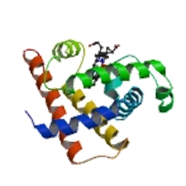null
SMILES CN(c1ccccc1)c1nccc(n1)-c1cnn2ncccc12
InChI Key InChIKey=XYEFJKRTJUALOK-UHFFFAOYSA-N
PDB links: 1 PDB ID matches this monomer.
Activity Spreadsheet -- Enzyme Inhibition Constant Data from BindingDB
 Found 4 hits for monomerid = 8127
Found 4 hits for monomerid = 8127
Affinity DataIC50: 1.99E+4nMpH: 7.2 T: 2°CAssay Description:The biochemical activity of compounds was determined by incubation with specific enzyme and substrate in the presence 2.5 uM ATP/ [gamma-32P] ATP. Af...More data for this Ligand-Target Pair
Affinity DataIC50: 186nMAssay Description:Displacement of Kinase tracer 236 from biotinylated DYRK1A (unknown origin) expressed in Escherichia coli BL21 (DE3) incubated for 1.5 hrs by TR-FRET...More data for this Ligand-Target Pair
Affinity DataIC50: 186nMAssay Description:Inhibition of recombinant human N-terminal Hex-tagged DYRK1A (127 to 485 residues) expressed in Escherichia coli BL21 (DE3) incubated for 1.5 hrs by ...More data for this Ligand-Target Pair
Affinity DataIC50: 1.99E+4nMAssay Description:The biochemical activity of compounds was determined by incubation with specific enzyme and substrate in the presence 2.5 uM ATP/ [gamma-32P] ATP. Af...More data for this Ligand-Target Pair

 3D Structure (crystal)
3D Structure (crystal)